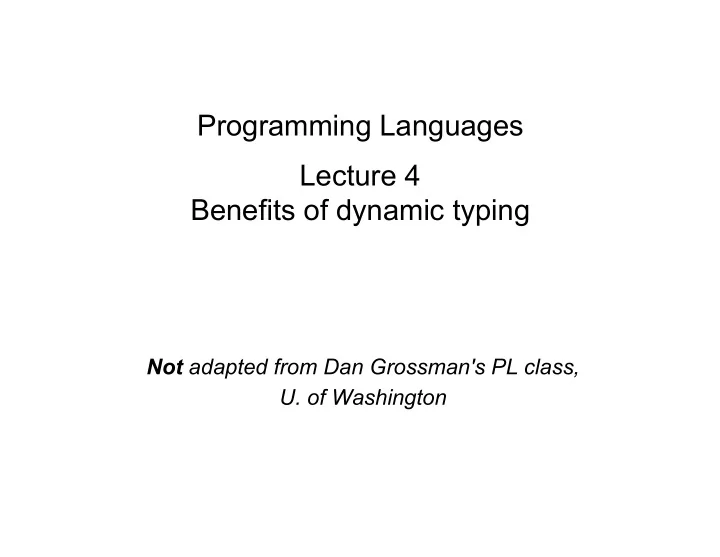

Programming Languages Lecture 4 Benefits of dynamic typing Not adapted from Dan Grossman's PL class, U. of Washington
Declaring functions in C++ vs Python C++ uses static typing : most code can be checked at compile-time to make sure rules involving types are not violated. int double(int n) { � return 2 * n; � } � Python uses dynamic typing: most code cannot be checked for type errors at compile-time; this has be delayed until run-time. def double(n): � return 2 * n � Spring 2013 CS360: Programming Languages 2
Dynamic typing • Racket (like most Scheme or Lisp dialects) is dynamically typed. • Some characteristics of dynamic typing: – Values have types, but variables do not. • A variable can refer to different types during its lifetime. – Most type-error bugs cannot be found before the program is run, and not until the offending line of code is encountered. • Possible to write code with type errors that aren't discovered for a long time, if buried in code that isn't executed often. – Traditionally (but not always), dynamically-typed languages are interpreted, whereas statically-typed languages are compiled. Spring 2013 CS360: Programming Languages 3
Some good things about dynamic typing • Enables polymorphism (enabling code to handle any data type). – Example: Calculating the length of a list. (define (length lst) (if (null? lst) 0 (+ 1 (length (cdr lst))))) versus int length_int_array(int_node* array) { if (array->next == NULL) return 0; else return 1 + length_int_array(array->next); } � Spring 2013 CS360: Programming Languages 4
Easier to create flexible data structures • In Racket, it's easy to create a list that can contain any other kind of data structure: – List of integers: '(1 2 3) – List of booleans: '(#f #f #t #f #t) – List of strings: '("a" "b" "c") – List of mixed types: '("a" 42 #f) – List of really mixed types: '(17 (3 #f) ("hi") -9 (1 (2 (3) 4 () ))) • Also, all of these lists will work with our length function! • Mixing types in a single data structure is not easy in statically- typed languages. • In C++, arrays or vectors must all hold the same type. Spring 2013 CS360: Programming Languages 5
"Manual" type-checking • Dynamically-typed languages often have some way for the programmer to discover the type of a variable. • In Racket (all of these return #t or #f): – number? � • also integer?, rational?, real? � – list? � – pair? � – string? � – boolean? � • Enables a single function to do different things depending on the type of an argument. Spring 2013 CS360: Programming Languages 6
Length of a list vs length of nested lists • For "regular" list – if empty list, return 0 – else return 1 + length of the cdr of the list. • For a list with possible nested lists ! – if empty list, return 0 – if the car of the list is a list ! do what? – else (car is not a list) ! do what? Spring 2013 CS360: Programming Languages 7
Length of a list vs length of nested lists • For "regular" list – if empty list, return 0 – else return 1 + length of the cdr of the list. • For a list with possible nested lists ! – if empty list, return 0 – if the car of the list is a list • return length of the car (which is a list) plus length of cdr – else (car is not a list) • return 1 + length of the cdr Spring 2013 CS360: Programming Languages 8
Length of a list vs length of nested lists (define (length-nested lst) � (cond ((null? lst) 0) � ((list? (car lst)) � (+ (length-nested (car lst)) � (length-nested (cdr lst)))) � (#t (+ 1 (length-nested (cdr lst)))))) � Spring 2013 CS360: Programming Languages 9
Let's do some practice ! • A "secret" of Racket/Scheme that I haven't told you: • Function bodies may contain more than one expression. – In "pure" functional programming, this isn't true. – But it's nice to have this facility at times. – For debugging, can use (display <whatever>) and (newline) • Example: (define (length lst) � (display lst) � (newline) � (if (null? lst) 0 (+ 1 (length (cdr lst))))) � Spring 2013 CS360: Programming Languages 10
Recommend
More recommend